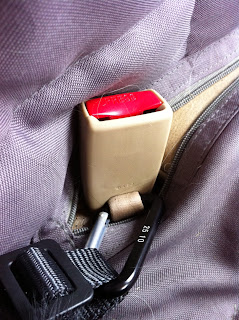Harnesses: There are a few crash-tested harnesses out on the market. The ones most commonly discussed at the Bergan Harness and the Kurgo Harness. Here is a comparison of both harnesses.
The Ruff Rider Roadie is another crash tested harness and the webbing used in the harness is independently tested to have a breaking force of 6,000 lbs, which is higher even than the requirements for human seatbelts. Canine Friendly makes a harness for dogs up to 85 pounds and lists the breaking strength for each component of the harness.
The Ruff Rider Roadie is another crash tested harness and the webbing used in the harness is independently tested to have a breaking force of 6,000 lbs, which is higher even than the requirements for human seatbelts. Canine Friendly makes a harness for dogs up to 85 pounds and lists the breaking strength for each component of the harness.
 |
| Bergan Harness |
 |
| Connectthe harness attachment to the child safety seat attachment in the car. |
 |
| Kurgo Harness |
ID Tags: Make sure your dog can be ID'd in the event of a crash! Consider reflective collars that will catch the light. You may wish to engrave/embroider the collars with your contact info since pet ID tags can be ripped off the collar.
ID Cards: If you are in an accident and are unable to care for your dogs, ID cards like these (or ones you make) can really help your rescuers. Include the dogs name, any special medical needs, and of course contact information. Make sure these have up to date, high quality photos for easy identification of the dog.
Current pictures: This isn't just for traveling its an everyday thing. If the dog gets lost having a recent, high quality photo that you can use to make "LOST" flyers will help.
 | ||
| While this picture of Maya as a baby is adorable, it wouldn't help me if she got lost. |
Another
thing to realize for EVERYONE’s safety, is that in a 30mph collision, loose
objects will travel at a weight of 20x their own weight with tremendous
velocity. So a 30# dog becomes 600# of force. The can of soda, the
various things lying around, they all become flying dangers moving at high
speed with lots of force. So developing a system where loose stuff is kept
in an enclosed bag or box that can be tied down is also very important.
Finally, depending on your finances and your dogs, you may wish to consider a collar that transmits the GPS location of your dog. There are a few systems that do this and they can really save lives. Tagg Tracker is the highest recommended of these products.
 . . | ||
| The lovely Cricket modeling the Tagg around her neck. |

No comments:
Post a Comment